This entry spotlights the Batman run in Detective Comics (#s 569-574, 579-81) and Batman: Gotham Knights #25 by Mike W. Barr, Alan Davis and others published in 1986-87 and 2002 by DC Comics. ”
“That Rhonda’s pretty neat, Batman. She sure knows how to make a guy feel good.”
“That’s what she’s best at, chum.”
“Huh? You mean she’s a — a–”
“She’s a lady, chum… just like Selina…“— Robin and Batman, Detective Comics #570, “The Last Laugh!”
In this set of one-off or two-off stories, Batman and Robin encounter some of their most classic foes. The Joker enacts a plot to turn Batman’s newest partner Catwoman back to a life of crime; The Scarecrow peddles a serum to sports stars and daredevils that removes their fear; A descendant of Professor Moriarty tries to enact a royal assassination plot of his forbear’s that failed a hundred years earlier; The Mad Hatter returns to a hat-themed life of crime (with tragic results); The Crime Doctor’s secret underworld clinic threatens the life of an ex-con trying to do right by his family; two Two-Faces embark on two different crime sprees, and battle for the title of “true” Two-Face.
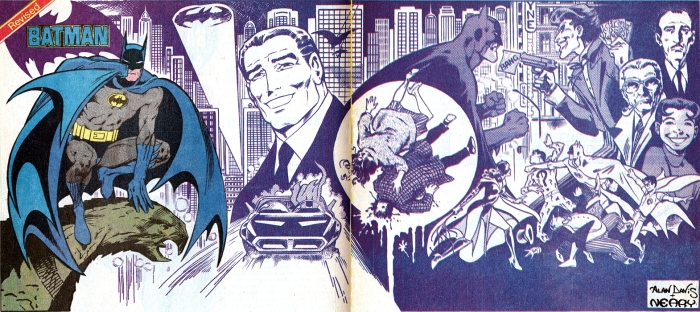
1986 was a big year at DC Comics, and for Batman in particular. Following the conclusion of the year-long Crisis on Infinite Earths storyline, DC adopted new origins and backgrounds for many of its characters, beginning with John Byrne’s Superman revision in the Man of Steel series, and expanding outwards in the wake of their line-wide Legends series later that year. With the retirement of longtime editor Julie Schwartz immediately before the Legends event, the reins of the Batman titles went to ’70s Bat-writer Denny O’Neil, who had edited Moon Knight and Daredevil to acclaim in previous years for Marvel. O’Neil’s inaugural editorial effort upon his return to DC was to take over editorial duties for the Dark Knight miniseries written and drawn by Frank Miller, which achieved almost immediate critical and commercial success. O’Neil commissioned a new Batman origin from Miller and his Daredevil collaborator David Mazzucchelli, which appeared serially in the ongoing Batman title under the title Year One. With the passage of time, this has become a nicely set-in-stone narrative: Crisis to Man of Steel and Dark Knight (and the unrelated Watchmen) in 1986 make way for more “serious” (or at least more gritty) offerings from DC, which lead to the death of the Jason Todd Robin, Alan Moore’s Killing Joke, and the general darkening of tone of the line, and Batman specifically. It didn’t have to go that way, though. At the same time as Miller and Mazzucchelli’s Year One was running in Batman, longtime Bat-writer Mike W. Barr and rising British talent Alan Davis began a short but memorable run in Detective Comics. While Batman is gruff, he isn’t the terse mental case of Miller’s conception, but is instead something of a blend of the Batmen that had come before: he’s a consummate detective, he cares for Robin like a son not a boot-camp trainee, he’s on good terms with his supporting cast, he cares for people as individuals and not as a faceless mass who need to be abstractly “protected”. It didn’t last, in part because of Davis’s departure after only a handful of issues, in part because Barr’s vision didn’t synch up with Miller’s more commercially successful one, and (I can’t help but think) in part because these “classic”-feeling stories were broken up by Barr’s Year Two story arc, which presents an uglier Batman without Robin fighting against an all-new enemy — the very opposite of what otherwise makes this run of Detective such a delight to read.
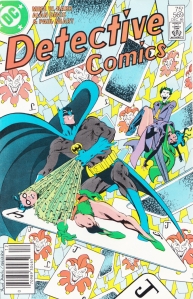
Mike W. Barr’s work on Batman is almost always what I give people who tell me that they’re interested in the character but don’t know where to start, particularly if they say they’re big fans of the ’90s Animated Series. The majority of his efforts with the character (short of his Son of the Demon graphic novel and Year Two and its related works — Full Circle and Batman Retroactive ’80s, which don’t do much for me*) capture something very close to the cartoon’s sense of the platonic Batman — not the selfish psycho Miller (and perhaps Snyder) gives us, and that seems to be the default setting for the portrayal of the character in the intervening 25 years. The Barr Detective issues particularly present a version of the character that seems comparatively well-adjusted, working in harmony with Robin, Alfred, the Commissioner, and the others (like the Elongated Man and Slam Bradley in issue 572) that he encounters. He lives in a Gotham full of giant props, and fights a colorful gallery of bizarre, gimmicky villains. In short, this is a Batman who looks a lot like the version of the character that appeared in the ’40s and ’50s, but with writing and sensibilities that place him more comfortably in the 1980s. There’s a moment in Barr and Davis’s first issue where Batman, Robin, Gordon and the Catwoman all try and piece together a clue left at police HQ by the Joker, using deductive methods little seen in Batman this side of the Adam West show. When the clue is figured out, an excited Robin shouts “Holy Gutenberg!” at the discovery of a rare book crime, and our heroes are off — but not before Batman grabs the lad’s shoulder and warns him “Never do that again!” This one moment works nicely to describe the charms of this whole series — it comes awfully close to going over the top, but almost always keeps itself in check. The dive bar McSurley’s, which becomes a recurring location in Barr and Davis’s Batman work, also offers a fine portrait of the balance that these books have — on the one hand, it’s so infested with criminals that it’s always a place to go to pursue a lead, but is full of reasonably sympathetic and even humorous characters that help give the strip a flavor similar to Will Eisner’s Spirit in its heyday (the late Barr/Davis collaboration in Batman: Gotham Knights #25 offers a particularly fine illustration of this in action).
*For my dollar, Year Two is less enjoyable than its adaptation/knockoff, the animated Mask of the Phantasm. Either in its film form, or in the comic adaptation by Kelly Puckett and Mike Parobeck, it glosses most of the gnarlier aspects of both Year One and Year Two, particularly Batman’s uncharacteristic bloodthirstiness in the latter. Though Year Two is meant to show the development of the character into the version we now know, the developments therein make him retroactively really ugly, and it’s hard to marry the character we see there with the rest of Barr’s treatment of him. Your mileage may vary, I guess.
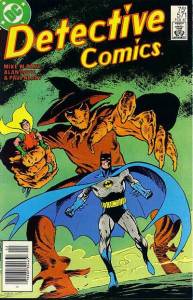
Shortly after the French Revolution, the British politician Edmund Burke wrote a popular book that decried it. Among other things, he said that if the Revolution continued the French would kill their king. It did, and they did, but they said they never would have thought of doing so if Burke hadn’t given them the idea: his worst fears gave rise to their own occurrence. The same can be said of the constant threat in these issues of harm coming to Robin. From Barr’s first issue, the dominant presence of the Boy Wonder seems to give way to concerns about the real harm he’s being placed in. In the Scarecrow issue, Batman reveals that the fear he used to overcome the villain’s drug was his concern at the boy’s death, and finally in #574, Batman spends the issue on tenterhooks after the boy is caught in the crossfire of a previous battle. Of course, we know now that this incarnation of Robin dies at the end of 1988, and it’s hard not to see a degree of Burkean prediction at play here on Barr’s part. However, Robin is one of the most fun aspects of this run. Particularly as drawn by Davis, Robin is fresh-faced and almost rubbery, a fine counterpart to the muscular, square-jawed, Don Newton-esque Batman he accompanies. He’s quick with a quip or a pun, and he’s eager to learn the ropes. The other Bat-writers of the time, Max Allan Collins and Jim Starlin, don’t have nearly the handle on him, and their efforts to “gritty” him up slowly compromise what Barr’s doing in his earliest issues: issue 574 shoehorns in elements of Year One and Collins’s “Street urchin” retcon origin for Jason Todd, and the Two-Face two-parter often has the boy hung up on that same origin’s murder of Todd’s father by Two-Face. These moments are rather few, though, and are notable as some of the only occasions where the story forces the acknowledgement that this is that Robin, rather than a more general, abstracted version that’s the more appropriate fit for these timeless-seeming stories. If you like Batman, you’ll almost assuredly find something to like here.
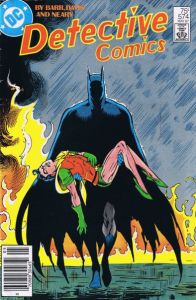
Alan Davis’s pencils, backed by the superb inks of Paul Neary (who also inked Davis on the last few issues of Outsiders, his previous collaboration with Barr), are dynamic and show, even this early in his career, the keen eye for layouts and action he is known for. Once Davis leaves, the book’s changing artists hurt some of the sense of consistency that might otherwise unify this run. That said, issue 579’s art by Norm Breyfogle a few months before he takes over the book’s reular art duties shows many of the charms of his later era-defining work. In comparison, the Two-Face two-parter as drawn by Jim Baikie (with inks by Pablo Marcos for its second half) isn’t able to stand up as well; while Baike’s a capable page designer, the rough look of his style (he’s best known for his collaboration with Alan Moore on Skizz) meshes poorly against the slicker, more stylized art of Davis and Breyfogle. All said, though, this looks like Batman: shadowy, but still brightly colored; expressionistic but firmly rooted in Gotham’s cityscape.
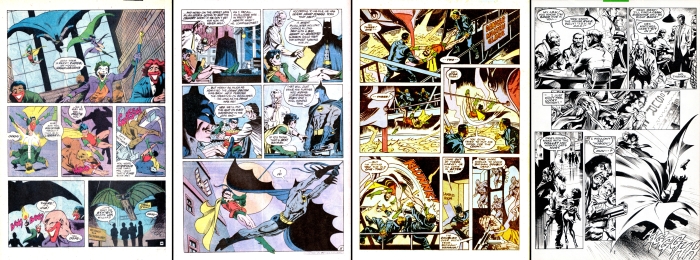
These issues have unfortunately never been collected together in the configuration I’ve discussed them here. The best single collection, Legends of the Dark Knight: Alan Davis, doesn’t include issues 579-81, and adds the first part of “Batman: Year 2” and its sequel, Batman: Full Circle. The Joker story in #s 569 and 570 are reprinted (with some ugly new coloring) in Stacked Deck, the expanded edition of The Greatest Joker Stories Ever Told from 1990. The Scarecrow story from #571 was reprinted in both the superb Batman in the Eighties collection and the villain-specific Batman: Scarecrow Tales trade. The short story in Gotham Knights was reprinted in Batman: Black and White Volume 3. The remaining issues, particularly the unreprinted #s 579-81, can be found quite inexpensively from the usual online usual online retailers (Midtown, mycomicshop/Lone Star, Mile High, Atomic Avenue). Issues 569, 570 and Gotham Knights #25 are also available digitally through Comixology.
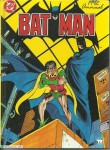 The header image for this post is a detail from the cover to the UK Batman Annual 1992, which features a re-colored, text-less version of Davis and Neary’s splash page to Detective #569.
The header image for this post is a detail from the cover to the UK Batman Annual 1992, which features a re-colored, text-less version of Davis and Neary’s splash page to Detective #569.